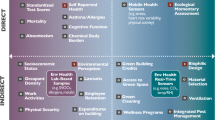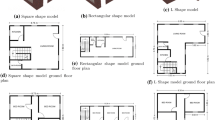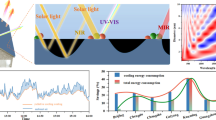Abstract
Building surface cool materials are novel materials that can reduce urban heat island intensity and decrease building energy consumption. This study investigated the impact of radiative properties of materials, façade orientation, and morphological parameters on energy consumption in six typical residential neighborhoods in Nanjing, China. The neighborhood energy consumption of 16 application schemes considering the façade orientation factor is compared to determine the best energy-saving scheme. Seasonal and annual energy-saving rates, savings in electricity costs, and the price ceiling for materials per unit area are analyzed. The results show that for low-rise buildings, using cool materials only on the roof can reduce the annual energy consumption by 1%. When cool or super cool materials are also used on the building façade, the annual energy saving rate can be up to 3.4% and 4.3%, respectively. Using cool materials on the south façade of buildings is not recommended due to significant heat loss in winter. Considering savings in electricity costs and the price ceiling for materials per unit area, the price of cool and super cool materials should be less than 3.0 and 3.7 RMB/m2, respectively, assuming a lifespan of eight years in Nanjing.
Similar content being viewed by others
References
Akbari H, Levinson R (2008). Evolution of cool-roof standards in the US. Advances in Building Energy Research, 2: 1–32.
Alhazmi M, Sailor DJ, Anand J (2022). A new perspective for understanding actual anthropogenic heat emissions from buildings. Energy and Buildings, 258: 111860.
Bonifacio-Bautista M, Ballinas M, Jazcilevich A, et al. (2022). Estimation of anthropogenic heat release in Mexico City. Urban Climate, 43: 101158.
Castleton HF, Stovin V, Beck SBM, et al. (2010). Green roofs; building energy savings and the potential for retrofit. Energy and Buildings, 42: 1582–1591.
Chatzipoulka C, Compagnon R, Kaempf J, et al. (2018). Sky view factor as predictor of solar availability on building façades. Solar Energy, 170: 1026–1038.
Chen G, Yang X, Yang H, et al. (2020). The influence of aspect ratios and solar heating on flow and ventilation in 2D street canyons by scaled outdoor experiments. Building and Environment, 185: 107159.
Chen L, Zhang K, Song G, et al. (2022). Study on the cooling performance of a radiative cooling-based ventilated roof for its application in buildings. Building Services Engineering Research and Technology, 43: 685–702.
Cui Z, Guo C, Zhao D (2022). Energy-saving and economic analysis of passive radiative sky cooling for telecommunication base station in China. Building Simulation, 15: 1775–1787.
Gentle AR, Smith GB (2015). A subambient open roof surface under the mid-summer Sun. Advanced Science, 2: 1500119.
Guo G, Zhou X, Wu Z, et al. (2016). Characterizing the impact of urban morphology heterogeneity on land surface temperature in Guangzhou, China. Environmental Modelling & Software, 84: 427–439.
Hang J, Chen X, Chen G, et al. (2020). The influence of aspect ratios and wall heating conditions on flow and passive pollutant exposure in 2D typical street canyons. Building and Environment, 168: 106536.
He Y, Yu H, Ozaki A, et al. (2020). Thermal and energy performance of green roof and cool roof: A comparison study in Shanghai area. Journal of Cleaner Production, 267: 122205.
He W, Li X, Zhang X, et al. (2023). Estimation of anthropogenic heat from buildings based on various data sources in Singapore. Urban Climate, 49: 101434.
Herath P, Thatcher M, Jin H, et al. (2023). Comparing the cooling effectiveness of operationalisable urban surface combination scenarios for summer heat mitigation. Science of the Total Environment, 874: 162476.
Hernández-Pérez I, Álvarez G, Xamán J, et al. (2014). Thermal performance of reflective materials applied to exterior building components—A review. Energy and Buildings, 80: 81–105.
Hu M, Zhao B, Suhendri S, et al. (2022). Experimental study on a hybrid solar photothermic and radiative cooling collector equipped with a rotatable absorber/emitter plate. Applied Energy, 306: 118096.
Imran HM, Kala J, Ng AWM, et al. (2018). Effectiveness of green and cool roofs in mitigating urban heat island effects during a heatwave event in the city of Melbourne in southeast Australia. Journal of Cleaner Production, 197: 393–405.
Jiang K, Zhang K, Shi Z, et al. (2023). Experimental and numerical study on the potential of a new radiative cooling paint boosted by SiO2 microparticles for energy saving. Energy, 283: 128473.
Kamal A, Abidi SMH, Mahfouz A, et al. (2021). Impact of urban morphology on urban microclimate and building energy loads. Energy and Buildings, 253: 111499.
Kolokotroni M, Giannitsaris I, Watkins R (2006). The effect of the London urban heat island on building summer cooling demand and night ventilation strategies. Solar Energy, 80: 383–392.
Kolokotroni M, Gowreesunker BL, Giridharan R (2013). Cool roof technology in London: An experimental and modelling study. Energy and Buildings, 67: 658–667.
Kong F, Sun C, Liu F, et al. (2016). Energy saving potential of fragmented green spaces due to their temperature regulating ecosystem services in the summer. Applied Energy, 183: 1428–1440.
Li Z, Zhang H, Wen C-Y, et al. (2020). Effects of frontal area density on outdoor thermal comfort and air quality. Building and Environment, 180: 107028.
Li L, Zhao Z, Wang H, et al. (2022). Variabilities of land surface stemperature and frontal area index based on local climate zone. IEEE Journal of Selected Topics in Applied Earth Observations and Remote Sensing, 15: 2166–2174.
Liu S, Shi K, Wu Y, et al. (2023). Suburban greening and suburbanization changing surface urban heat island intensity in China. Building and Environment, 228: 109906.
Lu M, Zeng L, Li Q, et al. (2023). Quantifying cooling benefits of cool roofs and walls applied in building clusters by scaled outdoor experiments. Sustainable Cities and Society, 97: 104741.
MacIntyre HL, Heaviside C (2019). Potential benefits of cool roofs in reducing heat-related mortality during heatwaves in a European city. Environment International, 127: 430–441.
Mandal J, Fu Y, Overvig AC, et al. (2018). Hierarchically porous polymer coatings for highly efficient passive daytime radiative cooling. Science, 362: 315–319.
MOHURD (2012). Design code for heating, ventilation and air conditioning of civil buildings. Ministry of Housing and Urban-Rural Development of China. Beijing: China Architecture & Building Press. (in Chinese)
Ng E, Yuan C, Chen L, et al. (2011). Improving the wind environment in high-density cities by understanding urban morphology and surface roughness: A study in Hong Kong. Landscape and Urban Planning, 101: 59–74.
Noro M, Lazzarin R (2015). Urban heat island in Padua, Italy: Simulation analysis and mitigation strategies. Urban Climate, 14: 187–196.
Nutkiewicz A, Mastrucci A, Rao ND, et al. (2022). Cool roofs can mitigate cooling energy demand for informal settlement dwellers. Renewable and Sustainable Energy Reviews, 159: 112183.
Peng S, Piao S, Ciais P, et al. (2012). Surface urban heat island across 419 global big cities. Environmental Science & Technology, 46: 696–703.
Pérez G, Coma J, Chàfer M, et al. (2022). Seasonal influence of leaf area index (LAI) on the energy performance of a green facade. Building and Environment, 207: 108497.
Peron F, De Maria MM, Spinazzè F, et al. (2015). An analysis of the urban heat island of Venice mainland. Sustainable Cities and Society, 19: 300–309.
Piselli C, Saffari M, de Gracia A, et al. (2017). Optimization of roof solar reflectance under different climate conditions, occupancy, building configuration and energy systems. Energy and Buildings, 151: 81–97.
Pisello AL (2017). State of the art on the development of cool coatings for buildings and cities. Solar Energy, 144: 660–680.
Pomerantz M (2018). Are cooler surfaces a cost-effect mitigation of urban heat islands? Urban Climate, 24: 393–397.
Raman AP, Abou Anoma M, Zhu L, et al. (2014). Passive radiative cooling below ambient air temperature under direct sunlight. Nature, 515: 540–544.
Romeo C, Zinzi M (2013). Impact of a cool roof application on the energy and comfort performance in an existing non-residential building. A Sicilian case study. Energy and Buildings, 67: 647–657.
Santamouris M, Synnefa A, Karlessi T (2011). Using advanced cool materials in the urban built environment to mitigate heat islands and improve thermal comfort conditions. Solar Energy, 85: 3085–3102.
Santamouris M (2014). Cooling the cities–A review of reflective and green roof mitigation technologies to fight heat island and improve comfort in urban environments. Solar Energy, 103: 682–703.
Scarano M, Mancini F (2017). Assessing the relationship between sky view factor and land surface temperature to the spatial resolution. International Journal of Remote Sensing, 38: 6910–6929.
Sinsel T, Simon H, Broadbent AM, et al. (2021). Modeling the outdoor cooling impact of highly radiative “super cool” materials applied on roofs. Urban Climate, 38: 100898.
Song J, Chen W, Zhang J, et al. (2020). Effects of building density on land surface temperature in China: Spatial patterns and determinants. Landscape and Urban Planning, 198: 103794.
Synnefa A, Saliari M, Santamouris M (2012). Experimental and numerical assessment of the impact of increased roof reflectance on a school building in Athens. Energy and Buildings, 55: 7–15.
Testa J, Krarti M (2017). A review of benefits and limitations of static and switchable cool roof systems. Renewable and Sustainable Energy Reviews, 77: 451–460.
Tian D, Zhang J, Gao Z (2023). The advancement of research in cool roof: Super cool roof, temperature-adaptive roof and crucial issues of application in cities. Energy and Buildings, 291: 113131.
Tong S, Li H, Zingre KT, et al. (2014). Thermal performance of concrete-based roofs in tropical climate. Energy and Buildings, 76: 392–401.
Wang N, Lv Y, Zhao D, et al. (2022a). Performance evaluation of radiative cooling for commercial-scale warehouse. Materials Today Energy, 24: 100927.
Wang X, Li H, Sodoudi S (2022b). The effectiveness of cool and green roofs in mitigating urban heat island and improving human thermal comfort. Building and Environment, 217: 109082.
Xu F, Gao Z (2022a). Frontal area index: A review of calculation methods and application in the urban environment. Building and Environment, 224: 109588.
Xu F, Gao Z (2022b). Study on indoor air quality and fresh air energy consumption under different ventilation modes in 24-hour occupied bedrooms in Nanjing, using Modelica-based simulation. Energy and Buildings, 257: 111805.
Xu F, Gao Z, Zhang J, et al. (2022). Influence of typical street-side public building morphologies on the ventilation performance of streets and squares. Building and Environment, 221: 109331.
Xu S, Sang M, Xie M, et al. (2023). Influence of urban morphological factors on building energy consumption combined with photovoltaic potential: A case study of residential blocks in central China. Building Simulation, 16: 1777–1792.
Yang J, Mohan Kumar DL, Pyrgou A, et al. (2018). Green and cool roofs’ urban heat island mitigation potential in tropical climate. Solar Energy, 173: 597–609.
Yang J, Shi Q, Menenti M, et al. (2021). Observing the impact of urban morphology and building geometry on thermal environment by high spatial resolution thermal images. Urban Climate, 39: 100937.
Zhai Y, Ma Y, David SN, et al. (2017). Scalable-manufactured randomized glass-polymer hybrid metamaterial for daytime radiative cooling. Science, 355: 1062–1066.
Zhang M, Gao Z (2021). Effect of urban form on microclimate and energy loads: Case study of generic residential district prototypes in Nanjing, China. Sustainable Cities and Society, 70: 102930.
Zhu Y, Li B, Liu J, et al. (2012). Influences of building floor area ratio on local thermal climate in high latitude severe cold area. Building Science, 28(6): 78–83. (in Chinese)
Zinzi M (2016). Exploring the potentialities of cool facades to improve the thermal response of Mediterranean residential buildings. Solar Energy, 135: 386–397.
Acknowledgements
This study was financially supported by the National Natural Science Foundation of China (project No. 52278110) and the Postgraduate Research & Practice Innovation Program of Jiangsu Province, China (project No. KYCX23_0170).
Author information
Authors and Affiliations
Corresponding author
Ethics declarations
The authors declare that they have no known competing financial interests or personal relationships that could have appeared to influence the work reported in this paper. Jianshun Jensen Zhang is an Editorial Board member of Building Simulation.
Rights and permissions
About this article
Cite this article
Xu, F., Tian, D., Gao, Z. et al. The effects of cool materials, façade orientation, and morphological parameters on energy consumption at the residential neighborhood scale. Build. Simul. 17, 525–542 (2024). https://doi.org/10.1007/s12273-023-1096-z
Received:
Revised:
Accepted:
Published:
Issue Date:
DOI: https://doi.org/10.1007/s12273-023-1096-z




